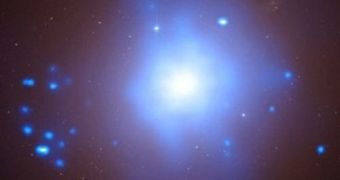Astronomers have discovered a light signature in a nearby galaxy that appears to have been produced by a white dwarf in the process of being ripped apart by tidal and gravitational forces.
In a new study, a team of experts proposes that the stellar remnant fell victim to a supermassive black hole that was about 1,000 times more massive than our own Sun.
The dark behemoth is lurking at the core of NGC 1399, an elliptical galaxy that lies approximately 65 million light-years away from our planet. Its existence was confirmed in past studies.
White dwarfs are the remnants of stars the size of the Sun. They develop once their precursors reach the end of their burning cycle. After passing through a red giant stage, the stars shed their atmosphere, and all that's left of them is a helium-burning core.
Using the NASA Chandra X-ray Observatory and the Magellan telescopes, investigators were able to determine that the white dwarf was destroyed near the core of NGC 1399. They say that the star may have passed too close to the black hole, and got destroyed as a result.
“We think these unusual signatures can be explained by a white dwarf that strayed too close to a black hole and was torn apart by the extreme tidal forces,” explains University of Michigan expert Joel Bregman.
Chandra determined that the galactic core in question is host to an ultraluminous X-ray source (ULX), which is an object that produces more radiation than any star, but far less than a quasar.
The exact nature of these sources has been the subject of debate in the astronomical community, but now it's slowly beginning to become clear that some of them are black holes. This may also be the case in NGC 1399, Daily Galaxy reports.
According to scientists, if the new findings stick then we could also collect new evidence on the existence of intermediate-mass black holes, a stepping stone between stellar black holes and their supermassive brethren.
The study would also mark the first discovery of a dark behemoth tearing apart a star that came too close to it. Such an instance has never been discovered by astronomers before.
“Astronomers have made cases for stars being torn apart by supermassive black holes in the centers of galaxies before, but this is the first good evidence for such an event in a globular cluster,” explains University of Alabama expert and study leader Jimmy Irwin.

 14 DAY TRIAL //
14 DAY TRIAL //